Chirp Spread Spectrum Communications
Papers and Code
A Secure Affine Frequency Division Multiplexing for Wireless Communication Systems
Oct 02, 2025Affine frequency division multiplexing (AFDM) has garnered significant attention due to its superior performance in high-mobility scenarios, coupled with multiple waveform parameters that provide greater degrees of freedom for system design. This paper introduces a novel secure affine frequency division multiplexing (SE-AFDM) system, which advances prior designs by dynamically varying an AFDM pre-chirp parameter to enhance physical-layer security. In the SE-AFDM system, the pre-chirp parameter is dynamically generated from a codebook controlled by a long-period pseudo-noise (LPPN) sequence. Instead of applying spreading in the data domain, our parameter-domain spreading approach provides additional security while maintaining reliability and high spectrum efficiency. We also propose a synchronization framework to solve the problem of reliably and rapidly synchronizing the time-varying parameter in fast time-varying channels. The theoretical derivations prove that unsynchronized eavesdroppers cannot eliminate the nonlinear impact of the time-varying parameter and further provide useful guidance for codebook design. Simulation results demonstrate the security advantages of the proposed SE-AFDM system in high-mobility scenarios, while our hardware prototype validates the effectiveness of the proposed synchronization framework.
LoRa Fine Synchronization with Two-Pass Time and Frequency Offset Estimation
Feb 12, 2025



LoRa is currently one of the most widely used low-power wide-area network (LPWAN) technologies. The physical layer leverages a chirp spread spectrum modulation to achieve long-range communication with low power consumption. Synchronization at long distances is a challenging task as the spread signal can lie multiple orders of magnitude below the thermal noise floor. Multiple research works have proposed synchronization algorithms for LoRa under different hardware impairments. However, the impact of sampling frequency offset (SFO) has mostly either been ignored or tracked only during the data phase, but it often harms synchronization. In this work, we extend existing synchronization algorithms for LoRa to estimate and compensate SFO already in the preamble and show that this early compensation has a critical impact on the estimation of other impairments such as carrier frequency offset and sampling time offset. Therefore it is critical to recover long-range signals.
NELoRa-Bench: A Benchmark for Neural-enhanced LoRa Demodulation
Apr 20, 2023



Low-Power Wide-Area Networks (LPWANs) are an emerging Internet-of-Things (IoT) paradigm marked by low-power and long-distance communication. Among them, LoRa is widely deployed for its unique characteristics and open-source technology. By adopting the Chirp Spread Spectrum (CSS) modulation, LoRa enables low signal-to-noise ratio (SNR) communication. The standard LoRa demodulation method accumulates the chirp power of the whole chirp into an energy peak in the frequency domain. In this way, it can support communication even when SNR is lower than -15 dB. Beyond that, we proposed NELoRa, a neural-enhanced decoder that exploits multi-dimensional information to achieve significant SNR gain. This paper presents the dataset used to train/test NELoRa, which includes 27,329 LoRa symbols with spreading factors from 7 to 10, for further improvement of neural-enhanced LoRa demodulation. The dataset shows that NELoRa can achieve 1.84-2.35 dB SNR gain over the standard LoRa decoder. The dataset and codes can be found at https://github.com/daibiaoxuwu/NeLoRa_Dataset.
A Survey on Scalable LoRaWAN for Massive IoT: Recent Advances, Potentials, and Challenges
Feb 22, 2022
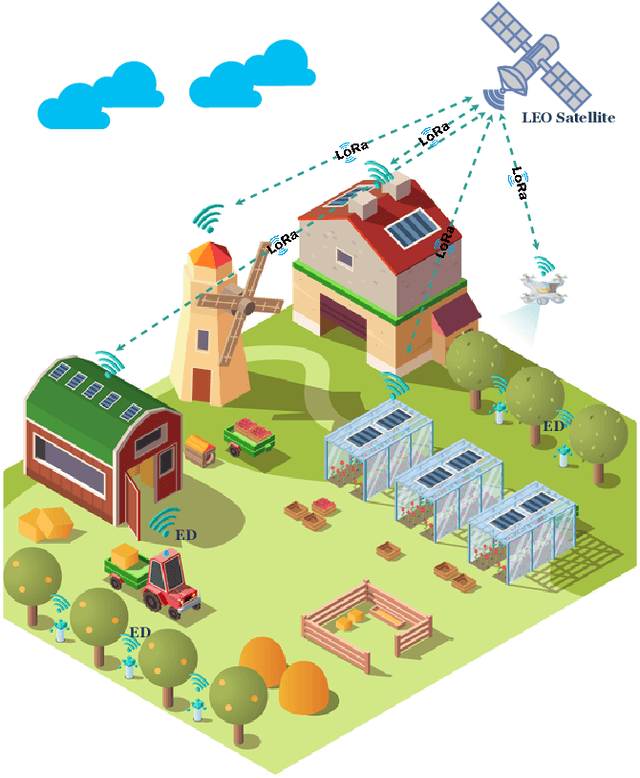
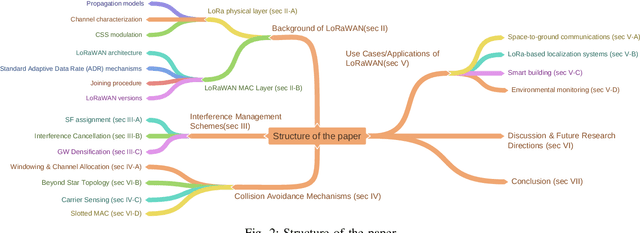
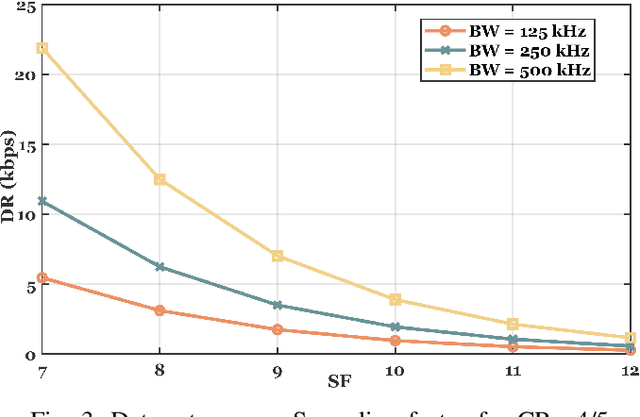
Long Range (LoRa) is the most widely used technology for enabling Low Power Wide Area Networks (LPWANs) on unlicensed frequency bands. Despite its modest Data Rates (DRs), it provides extensive coverage for low-power devices, making it an ideal communication system for many Internet of Things (IoT) applications. In general, LoRa radio is considered as the physical layer, whereas Long Range Wide Area Networks (LoRaWAN) is the MAC layer of the LoRa stack that adopts star topology to enable communication between multiple End Devices (EDs) and the network Gateway (GW). The Chirp Spread Spectrum (CSS) modulation deals with LoRa signals interference and ensures long-range communication. At the same time, the Adaptive Data Rate (ADR) mechanism allows EDs to dynamically alter some LoRa features such as the Spreading Factor (SF), Code Rate (CR), and carrier frequency to address the time variance of communication conditions in dense networks. Despite the high LoRa connectivity demand, LoRa signals interference and concurrent transmission collisions are major limitations. Therefore, to enhance LoRaWAN capacity, the LoRa alliance released many LoRaWAN versions, and the research community provided numerous solutions to develop scalable LoRaWAN technology. Hence, we thoroughly examined LoRaWAN scalability challenges and the state-of-the-art solutions in both the PHY and MAC layers. Most of these solutions rely on SF, logical, and frequency channel assignment, while others propose new network topologies or implement signal processing schemes to cancel the interference and allow LoRaWAN to connect more EDs efficiently. A summary of the existing solutions in the literature is provided at the end of the paper by describing the advantages and drawbacks of each solution and suggesting possible enhancements as future research directions.
Frequency-Shift Chirp Spread Spectrum Communications with Index Modulation
Feb 09, 2021
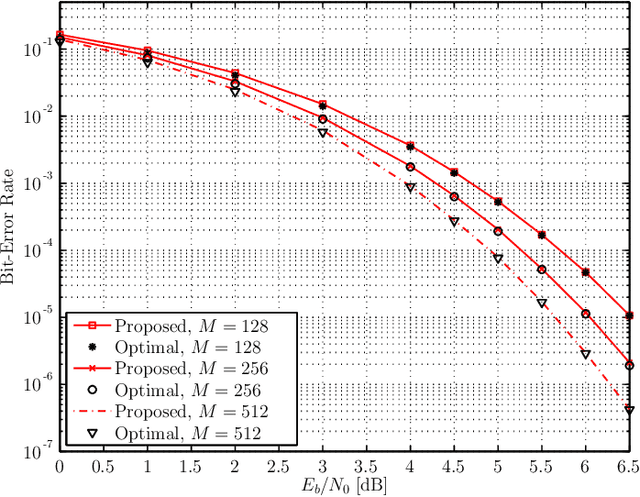

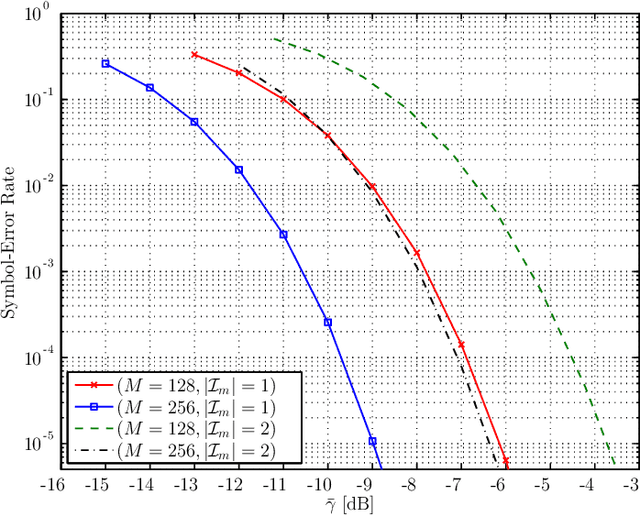
This paper introduces a novel frequency-shift chirp spread spectrum (FSCSS) system with index modulation (IM). By using combinations of orthogonal chirp signals for message representation, the proposed FSCSS-IM system is very flexible to design and can achieve much higher data rates than the conventional FSCSS system under the same bandwidth. The paper presents optimal detection algorithms, both coherently and non-coherently, for the proposed FSCSS-IM system. Furthermore, a low-complexity non-coherent detection algorithm is also developed to reduce the computational complexity of the receiver, which is shown to achieve near-optimal performance. Results are presented to demonstrate that the proposed system, while enabling much higher data rates, enjoys similar bit-error performance as that of the conventional FSCSS system.
A Chirp Spread Spectrum Modulation Scheme for Robust Power Line Communication
Jun 26, 2021
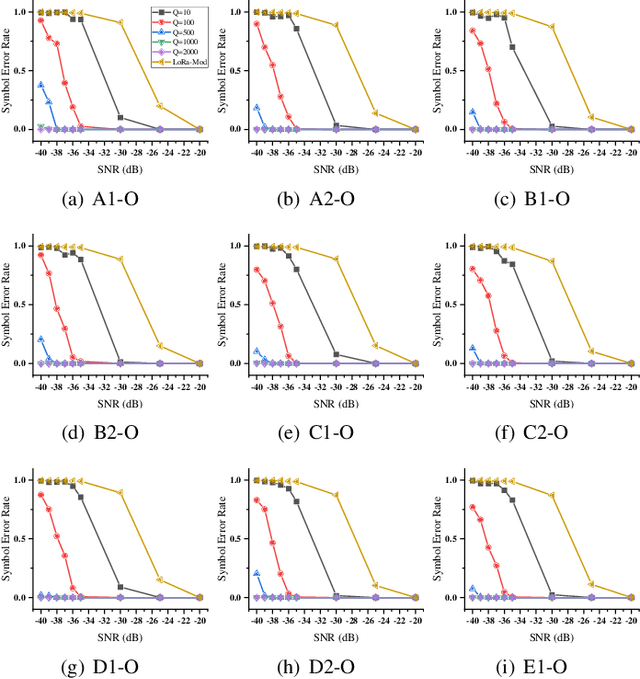


This paper proposes the use of a LoRa like chirp spread spectrum physical layer as the basis for a new Power Line Communication modulation scheme suited for low-bandwidth communication. It is shown that robust communication can be established even in channels exhibiting both extreme multipath interference and low SNR (-40dB), with synchronisation requirements significantly reduced compared to conventional LoRa. ATP-EMTP simulations using frequency dependent line and transformer models, and simulations using artificial Rayleigh channels demonstrate the effectiveness of the new scheme in providing load data from LV feeders back to the MV primary substation. We further present experimental results based on a Field Programmable Gate Array hardware implementation of the proposed scheme.
Design of Non-Coherent and Coherent Receivers for Chirp Spread Spectrum Systems
May 06, 2021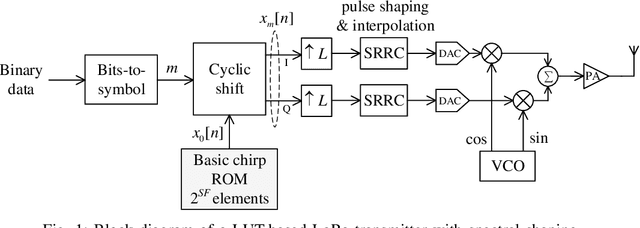

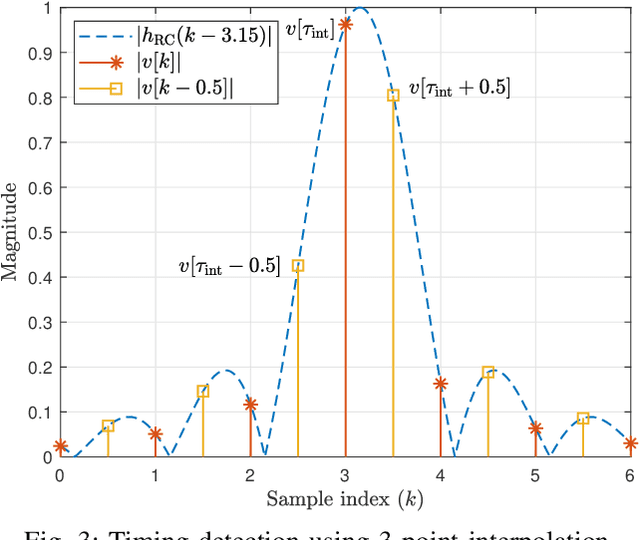

LoRaWAN is a prominent communication standard to enable reliable low-power, long-range communications for the Internet of Things (IoT). The modulation technique used in LoRaWAN, commonly known as LoRa modulation, is based on the principle of chirp spread spectrum (CSS). While extensive research has been conducted on improving various aspects of LoRa transmitter, the design of LoRa receivers that can operate under practical conditions of timing and frequency offsets is missing. To fill this gap, this paper develops and presents detailed designs of timing, frequency and phase synchronization circuits for both non-coherent and coherent detection of CSS signals. More importantly, the proposed receiver can be used to detect the recently proposed CSS-based modulation that embeds extra information bits in the starting phases of conventional CSS symbols. Such a transmission scheme, referred to as phase-shift keying CSS (PSK-CSS) helps to improve the transmission rates of the conventional CSS system. In particular, it is shown that the bit error rate performance of the PSK-CSS scheme achieved with the proposed practical coherent receiver has only 0.25 dB gaps as compared to the ideal co-coherent receiver.
DEFORM: A Practical, Universal Deep Beamforming System
Mar 18, 2022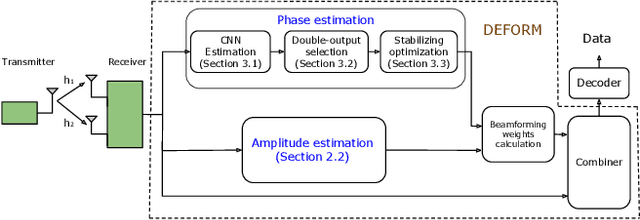



We introduce, design, and evaluate a set of universal receiver beamforming techniques. Our approach and system DEFORM, a Deep Learning (DL) based RX beamforming achieves significant gain for multi antenna RF receivers while being agnostic to the transmitted signal features (e.g., modulation or bandwidth). It is well known that combining coherent RF signals from multiple antennas results in a beamforming gain proportional to the number of receiving elements. However in practice, this approach heavily relies on explicit channel estimation techniques, which are link specific and require significant communication overhead to be transmitted to the receiver. DEFORM addresses this challenge by leveraging Convolutional Neural Network to estimate the channel characteristics in particular the relative phase to antenna elements. It is specifically designed to address the unique features of wireless signals complex samples, such as the ambiguous $2\pi$ phase discontinuity and the high sensitivity of the link Bit Error Rate. The channel prediction is subsequently used in the Maximum Ratio Combining algorithm to achieve an optimal combination of the received signals. While being trained on a fixed, basic RF settings, we show that DEFORM DL model is universal, achieving up to 3 dB of SNR gain for a two antenna receiver in extensive experiments demonstrating various settings of modulations, bandwidths, and channels. The universality of DEFORM is demonstrated through joint beamforming relaying of LoRa (Chirp Spread Spectrum modulation) and ZigBee signals, achieving significant improvements to Packet Loss/Delivery Rates relatively to conventional Amplify and Forward (LoRa PLR reduced by 23 times and ZigBee PDR increased by 8 times).
Alternative Chirp Spread Spectrum Techniques for LPWANs
Feb 18, 2021

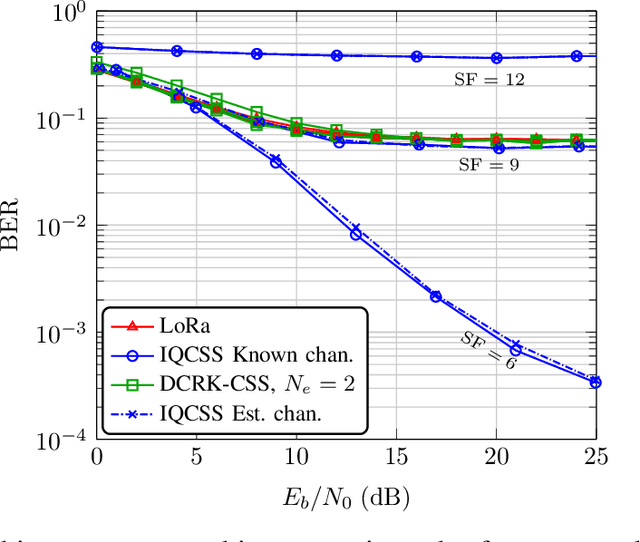

Chirp spread spectrum (CSS) is the modulation technique currently employed by Long-Range (LoRa), which is one of the most prominent Internet of things wireless communications standards. The LoRa physical layer (PHY) employs CSS on top of a variant of frequency shift keying, and non-coherent detection is employed at the receiver. While it offers a good trade-off among coverage, data rate and device simplicity, its maximum achievable data rate is still a limiting factor for some applications. Moreover, the current LoRa standard does not fully exploit the CSS generic case, i.e., when data to be transmitted is encoded in different waveform parameters. Therefore, the goal of this paper is to investigate the performance of CSS while exploring different parameter settings aiming to increase the maximum achievable throughput, and hence increase spectral efficiency. Moreover, coherent and non-coherent reception algorithm design is presented under the framework of maximum likelihood estimation. For the practical receiver design, the formulation of a channel estimation technique is also presented. The performance evaluation of the different variants of CSS is carried out by inspection of the symbol error ratio as a function of the signal-to-noise ratio together with the maximum achievable throughput each scheme can achieve.
Impact of Phase Noise and Oscillator Stability on Ultra-Narrow-Band-IoT Waveforms for Satellite
Jan 15, 2021



It has been shown that ultra-narrow-band (uNB) massive machine type communication using very compact devices with direct access to satellites is possible at ultra low rate. This enables global ubiquitous coverage for terminals without terrestrial service in the Internet of Remote Things and provides access to any satellite up to the the geostationary earth orbit. The lower data rate for waveforms providing uNB communication is set by the stability and the phase noise of the applied oscillators. In this paper we analyze the physical layer of two candidate waveforms, which are LoRa and Unipolar Coded Chirp-Spread Spectrum (UCSS) with respect to phase noise and oscillator frequency drifts. It is figured out that UCSS is more robust against linear frequency drifts, which is the main source of error for uNB transmissions.
 Add to Chrome
Add to Chrome Add to Firefox
Add to Firefox Add to Edge
Add to Edge